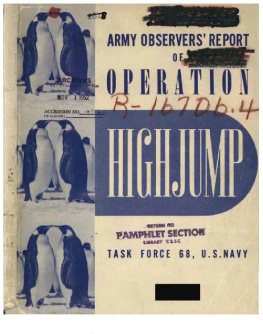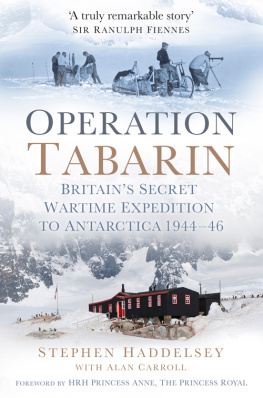Distribution:
OSW (2); WDGS Divs (5), except R&D (300); WDSS Divs (2); AAF (10); AGF (50); T (2); Dept (2); Base Comd (2); Def Comd (2); AAF Comd (5); Arm & Sv Bd (2); Adm Sv (2); Tech Sv (15); AMA (2); FC (1); PG (2); Ars (2); Div Eng (2); GH (1); RH (1); Disp (1); Sch (2), except Gen & Sp Sv Sch (5); USMA (5); Tng C (2); Class III Instls (1); A (5); CHQ
(2); D (2); D (ATC) (2); D (A Tng Comd) (2); B (2); R (1); AF (5); W (2); G (1); Special distribution.
For explanation of distribution formula, see TM 38-405.
PREFACE
This report represents the. combined observations of Army personnel assigned to Task Force 68, Operation HIGHJUMP", Naval Antarctic Development Project, December 1946 to April 1947. The War Department responded willingly to a Navy invitation to send observers on this important expedition and increased its representation to sixteen, ten more than originally allotted by the Navy. (The personnel included four men with prior Antarctic experience.)
The Army cooperated with the Navy in respect to materiel items, particularly in regard to Ordnance vehicles and Quartermaster items of issue including special rations, tents, skis, stoves, sleeping bags, and cold weather clothing.
The Army observers were primarily a cross-section representing Army Air Forces, Army Ground Forces, and some of the technical services. The combined background permitted a general coverage of primary Army interests, particularly in the fields of polar research, engineering, communications, personal health and protection, surface transportation, meteorology, photography, air operations, emergency rescue, and various fields of scientific research.
By Navy request, the Army observers5 activity was to be segregated specifically from expedition operations. However, they asked for or accepted voluntary work assignments which would permit better opportunities for military observations. The Army personnel therefore had an active part in many operational activities including exploratory flights, air operations, base construction, photography, oversnow travel, meteorology, emergency rescue planning, training, scientific projects, and other activities.
The Army observers were concentrated for the most part with the Central Group which operated on the Ross Shelf Ice, as there was little of concern to the Army in respect to ship movements and seaplane activity of the Eastern and Western Groups. The War Department issued no special instructions to its observers, but appointed a senior observer who was well qualified as to the broad interests of the Army in high latitude operations and thoroughly cognizant as to Antarctic conditions. The senior Army observer organized the observation team and clarified fields of responsibility. The trip to Antarctica aboard the U. S. S. Mount Olympus , Flagship of the Task Force, was spent in frequent conference to prepare for maximum utilization of observation opportunities in the Antarctic. The plan worked smoothly while on the ice permitting the observers to work independently with only occasional coordination with the senior observer. On the return, the observers held daily conferences and prepared necessary joint logs and reports by means of dictation into a wire recorder. The specific topics for which the observers were individually qualified and responsible were prepared separately.
Within one week upon return to the United States the Army observation reports, in rough draft, including illustrations, were submitted to the War Department and were made available in most instances to the agencies primarily concerned. The publication of the combined Army observers7 report was purposely postponed until the Navys much larger report could have prior release. It is felt that the Army observers report, although it does not attempt to cover ship operations or problems of primary concern to the Navy, does contain many valuable independent observations from an Army viewpoint that do not constitute a duplication of the Navys Report of Operation Highjump. (U. S. Navy Antarctic Development Project 1947. )
The Armys combined observers report has in no manner attempted to evaluate or criticize the Navys Operation Highjump. It has been a conscientious effort to report the operation as planned and executed. Each contributor was requested to consider the operation in the light of the problems with which the Army would be faced, were it to undertake a similar project, and to make recommendations as to how difficulties could be obviated.
The War Department is indebted to the Navy for including Army observers on Operation Highjump under the commendable leadership of Rear Admiral R. E. Byrd and Rear Admiral R. H. Cruzen, The Army observers, and those who have assisted in production of this report, are to be commended for the very valuable contributions they have made to the War Department research and development program.
H. S. AURAND
Major General, GSC
Director of Research & Development War Department General Staff
CONTENTS
RESTRICTED
1 INTRODUCTION
SECTION I. Planning of Operation "HIGHJUMP"
1. Command of Project.
The United States Navys Antarctic Development Project, 1947, identified by the code word HIGHJUMP, was established by the Chief of Naval Operations to be carried out by Task Force 68 of the Atlantic Fleet. This force, commanded by Rear Admiral Richard H. Cruzen, was under the operational and administrative control of the Commander in Chief, U. S. Atlantic Fleet. Technical control was retained by the Chief of Naval Operations and exercised through Rear Admiral Richard E. Byrd, USN (Ret.), who was designated as the officer in charge of the project and during the conduct of operations exercised technical control. Tactical command at all times remained with the Commander Task Force 68.
2. Assumptions.
a. That ice conditions would permit access to the proposed operating areas.
b . That weather conditions encountered would permit conduct of planned air and surface operations.
c . That no vessels of the task force would spend the winter in the Antarctic.
3. Objectives of Project
a. To establish a temporary base and airstrip on the Ross Shelf Ice in the vicinity of Little America, Antarctica, and conduct systematic long range air exploration of the Antarctic Continent therefrom, and conduct naval operations and carry out specific projects for training naval personnel, testing materials, and amplifying scientific knowledge of the Antarctic.
b . To extend the area of exploration of the Antarctic Continent, utilizing aircraft based on tenders operating around the continental perimeter.
c. To examine the limits and character of the ice belt surrounding the Antarctic Continent and the coast line where accessible by surface ships.
d. To carry out assigned naval and scientific projects in order to
(1) Train personnel and test materiel in the frigid zones.
(2) Explore the largest practicable area of the Antarctic Continent.
(3) Determine the feasibility of establishing, maintaining, and utilizing bases in the Antarctic, and investigate possible base sites.
(4) Develop techniques for establishing, maintaining, and utilizing bases on ice, with particular reference to later applicability of such techniques to operations in interior of ice caps where conditions are comparable to those in the Antarctic.











